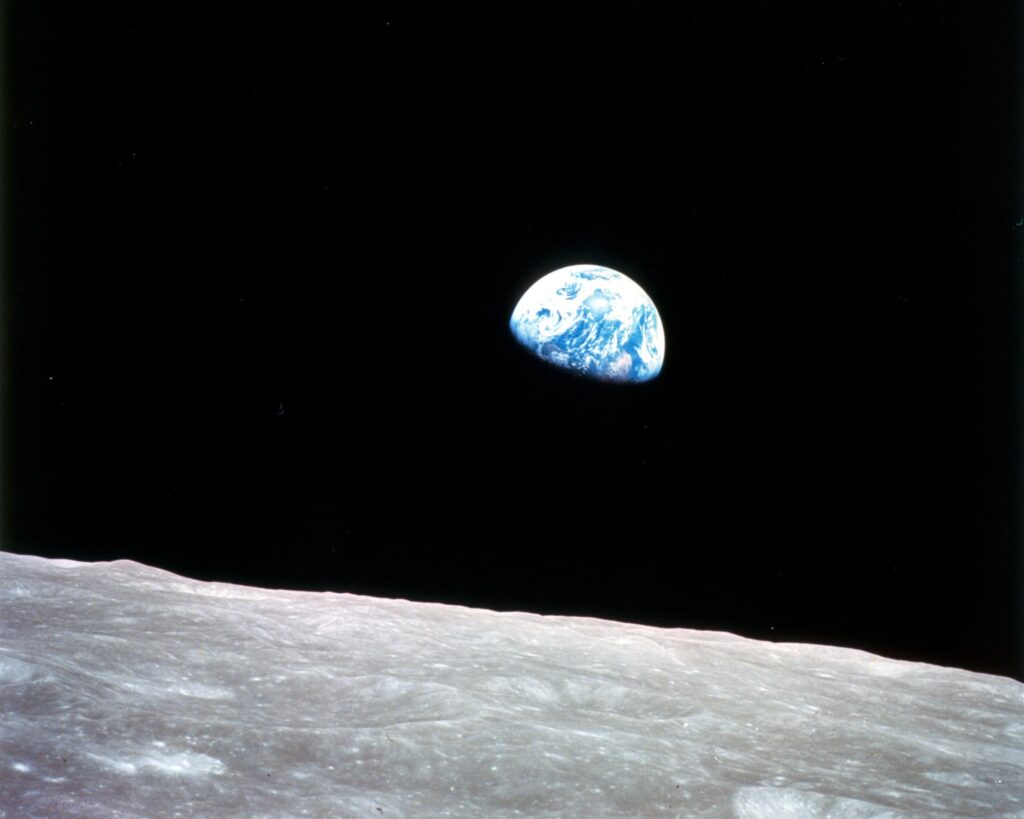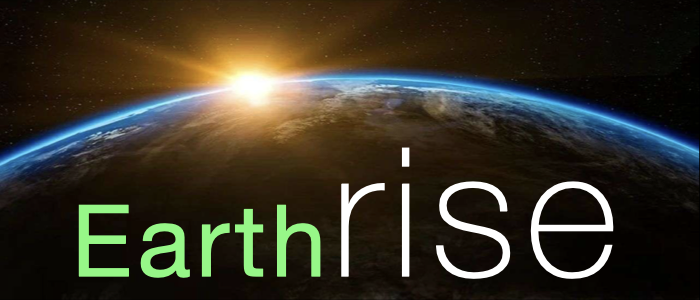||| EARTHRISE BY JAY KIMBALL |||
Three men stepped into a vehicle, traveled nonstop for three days, and took a picture that forever changed how we see our world. It was Christmas Eve, 1968. Orcas islander Bill Anders took the photo as he orbited the moon with fellow astronauts Frank Borman and James Lovell, on the Apollo 8 mission. That photo came to be called Earthrise.

NASA describes the effect that powerful image had on the world:
“Earthrise became one of the most famous photographs from all of the Apollo missions and one of the most reproduced space photographs of all time. It has been credited for inspiring the beginning of the environmental movement. In Life Magazine’s 100 Photographs that Changed the World edition, wilderness photographer Galen Rowell called Earthrise “the most influential environmental photograph ever taken.”
“It was the most beautiful, heart-catching sight of my life,” Frank Borman recalled, “one that sent a torrent of nostalgia, of sheer homesickness, surging through me.”
On Christmas Day, the front page of the New York Times featured an essay by poet Archibald MacLeish. Moved by the images from space, MacLeish wrote: “To see the earth as it truly is, small and blue and beautiful in that eternal silence where it floats, is to see ourselves as riders on the earth together, brothers on that bright loveliness in the eternal cold — brothers who know now they are truly brothers.”
A New Vision of Earth
As a veteran of World War I, MacLeish’s call to come together was a plea for peace. Peace, in a year that had seen the assassinations of Martin Luther King Jr. and Robert F. Kennedy; the escalation of fighting in Vietnam, and anti-war protests.
The Beatles had just recorded the song While My Guitar Gently Weeps. The lyric, “With every mistake, we must surely be learning… Still my guitar gently weeps,” captured the zeitgeist of that violent and tumultuous year.
Yesterday, on Martin Luther King Jr. Day, I spoke with Bill Anders about what Earthrise meant to him. He said, “We came all this way to explore the Moon, and what we discovered was the Earth.” He paused and added, “A few weeks after we returned to Earth, I appreciated how Earthrise added energy to the environmental movement.”
Photographer Josh Druding said of Earthrise’s influence, “There were no signs of borders, religion or politics, just a vulnerable oasis sitting alone in the vast infinite of space.”
Earthrise became a moment of hope and grace for the world. It expanded our notion of home, deepening our connection with Earth.
Earthrise: A Climate Action Journal
This climate action journal is named for and dedicated to that spirit. Forthcoming posts will offer information and actions we can take together, locally and globally, as we care for this precious Earth.
“The best way to heal a living system, is to connect it with more parts of itself.” ~ Margaret Wheatley
If you like what you read here, pass it forward to a few friends and ask them to do the same. Like a pebble tossed in a pond, the rings emanate outward, reflecting and growing exponentially. “Going exponential” is what it will take to reverse the climate extremes that are accelerating around us.
Thank you…
• Get an alert when there’s a new Earthrise post: Subscribe
A Man on the Moon author Andrew Chaikin on Earthrise



Wonderful. I look forward to reading each installment.
Thanks, Jay, for reminding those of us who can remember what Apollo 8 did for us at the end of 1968 – the most turbulent year in my lifetime. The Tet offensive in January proving that the Viet Cong were not done, then Senator Eugene McCarthy running for President to challenge President Johnson over Viet Nam, then Johnson deciding not to run for re-election, then Martin Luther King’s assassination and the riots which followed, then Sen. Robert F. Kennedy being assassinated just as he was winning the California presidential primary, then the summer demonstrations and violence at the Democratic National Convention in Chicago, then the Soviet Union invading Czechoslovakia, the war in Vietnam continuing to go sideways, then the November presidential election in which an avowed segregationist received 13% of the national popular vote . . . and then, in December, those 3 guys got up on top of that big rocket and soon, with Walter Cronkite taking us along with them, they became the first 3 humans to see the far side of the moon, and the first to see an earthrise — reminding us that even when we are depressed from overwhelming negativity, human nature still moves us to look for the things that give us hope and pride . . . and heroes like Bill Anders. He did a lot for our nation, and then a lot for Orcas in his later years. A very modest and unassuming hero. The best kind.
Jay, thanks for adding to our awareness of environmental issues. I hope you will highlight the actions by the many individuals and local groups whose contributions are adding to the quality of life on Orcas and beyond.
Great column Jay…looking forward to more of your inspiring series’s. It’s a wonderful start for 2023!
Profoundly beautiful and powerful.
Thank-you, Jay!
Great idea, Jay. Looking forward to more.
Thank you, Jay. I look forward to your future posts on this subject. You are always thoughtful and insightful! And the world can not hear enough of this information!